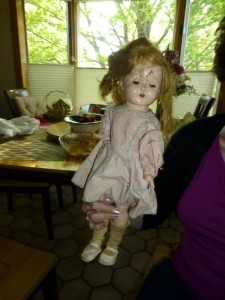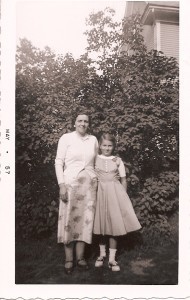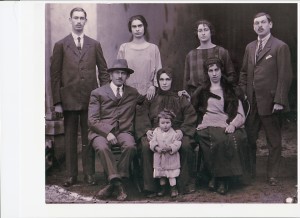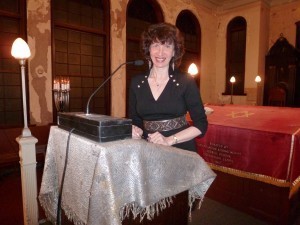Hanna Perlstein Marcus's Blog, page 13
August 8, 2013
Next Free Promotion Coming Up!
The next Kindle free promotion is coming up on Monday, August 12 to Friday, August 16. It’s the longest free promotion period for Sidonia’s Thread so far! This is a chance to read the story on your Kindle and if you like it, recommend it to your friends and family! I hope to hear from you on Facebook, Goodreads, or directly at hanna@hannamarcus.com.

June 19, 2013
Cinderella’s Destiny
Once, a long time ago, she was a beautiful girl. Her wavy, golden blonde hair hung to just below her shoulders framing a shy, innocent-looking face. Blazing blue eyes and red lips added to her demure yet luminous visage. She wore a short-sleeved light pink dress with blue piping hemmed at her knees with white socks and white Mary Jane shoes. You couldn’t help but fall in love with her the moment your eyes met hers.
That’s what I did. I fell in love with her the moment my mother gave her to me on my fifth birthday. “It’s a Cinderella doll. She cost lotsa money, so take good care on her,” my mother said in her thick Hungarian accent.
“Thanks, ma,” I replied, “I will.” I remember being truly impressed at my mother’s taste in dolls since the ones I was used to seeing with the other little girls looked nothing like this one. Theirs looked more like stuffed dolls, light and flexible, a little on the chubby side, their facial and body features not very distinctive. I could tell that Cinderella was modeled with almost human qualities creating visible envy among my friends. Sometimes, in my mind, I would think that we looked a little alike.
I’m not sure whether her official name was Cinderella or not since most Cinderellas are dressed in much more formal, ballroom-worthy attire and mine was dressed in just a pretty pink informal dress, shoes and socks. But she was always Cinderella to me and always will be.
I played with her for quite some time until I became an adolescent. But then we seemed to have parted ways. She was relegated to some corner in my room shoved among the few other toys I owned as a child. I never forgot her, but she wasn’t that important to me anymore, my thoughts diverted to academics, boys, and the usual adolescent social scene.
When I grew up and moved to my own home, I brought her with me, but I didn’t pay much attention to her. For a long time, I wasn’t even sure where she was, perhaps at the bottom of some box in the laundry room or basement, abandoned by a once attentive young girl. But in the back of my mind, I still never forgot her.
Almost forty years went by and Cinderella and I only saw each other sparingly. Once in a while she would show up unannounced during a cleaning spree when I would give her the once over and notice that her dress was becoming a bit ragged and her hair could use a good comb over. But then, I just as quickly put her away again, not even thinking twice.
That is, until about a month ago. It has taken me that long to write about my recent interaction with my Cinderella. During a particularly intense cleaning, a family member found her at the bottom of a plastic bin in the laundry room. I hadn’t seen her for a very long time. Her golden hair was hanging from her half-exposed scalp, her pink dress had grown dull and suffered numerous tears, her socks had lost their elasticity and hung loosely around her ankles, her white shoes heavily scuffed. My son-in-law asked, “What do you want to do with this thing?” And suddenly, my mind wandered back to my mother’s and my small apartment on Osgood Street where I played contentedly with Cinderella, so proud of possessing such an exquisite doll. But now she looked nothing like the doll I remembered, so I hastily responded, “Well, I am supposed to be getting rid of things I don’t use anymore so I guess it’s time to throw it away. For the first time, I found myself referring to Cinderella as “it” rather than “her.”
We took the trash out to the edge of the lawn where the trash collectors were scheduled to pick it up the following day. I almost forgot that Cinderella was among my discarded garbage that next morning as I lazily looked out the window just at the precise moment that the truck came by. With its mechanical arm, it lifted up the trash can, straight up, and then turned it over, dropping its contents into the cavernous dumpster in back. But wait, something didn’t make it into the dumpster. It fell out on the way up and landed on the road at the edge of the curb. I could tell by the flash of pink that it was her. Surely, this must have been a sign from my late mother that Cinderella was meant to stay with me for the rest of my life. That must have been my mother’s intent.
But this story doesn’t have the ending you might be expecting, because in that split second that I thought about running outside and rescuing my Cinderella, the truck proceeded to find her in her resting spot and ran her over, grinding her to smithereens. All I could do was to go out with my hand shovel and dust pan and scoop her up in all her fragmented majesty and put the pieces back into the trash. Thus, the doll that I so hastily discarded haunted me for the next few weeks and perhaps still does as I attempt to find some meaning in this bizarre circumstance.
Is there a lesson to be learned in all of this? I like to find a lesson in most everything that happens in my life, but I’m not sure about this one. Maybe, if it was meant as a sign from my dear mother, Sidonia, it was that sometimes you just have to let go of certain things and focus on your present and future. Maybe it was just that time for me. But, I know I’ll never forget my Cinderella.

May 29, 2013
The Sidonia Skirt
Henry Ford once said, “You can have any color as long as it’s black.” Well, Sidonia’s skirts weren’t quite as monochrome as that, but certainly black was a real favorite, especially in her later designs. Black matches with everything.
Through the years, Sidonia’s skirts were made, indeed, of many colors, prints, designs, and fabrics. But they had some common characteristics. If made for my shape, they invariably incorporated her fashion philosophy: simple lines, straight or A-line form, no extra frills, fitted to the body. They possessed four darts in the front and back and a slit vent in the back. Sometimes, if she was low on fabric, a skirt might have had a seam in the center front as well as the back and sides. During her time, skirts always had a waist band and hers were one and one quarter inch in width including two sets of hooks and eyes set inside and one hook and bar at the edge for fasteners.
Sidonia’s skirts were mostly above the knee, sometimes way above. Although some of her customers may have requested a maxi length, she would rarely allow it for me. She wanted to take advantage of my long and lean legs.
These days, I can’t always fit into one of my mother’s skirt designs. My dimensions have shifted just a bit, but that’s all it takes to alter the fit of a garment which was made to my exact measurements. When I speak before audiences now, I never know whether I will be wearing a garment made by Sidonia or not. When it’s my lucky day, I often wow an audience by revealing that my skirt or outfit is a Sidonia design. What’s my quick way of showing the audience its authenticity? Placing both my hands into the deep-set hidden side-seam pockets of a skirt or dress, a sure sign of a Sidonia skirt! It just never goes out of style.

May 15, 2013
Why I Hated My Mother…Or Did I?
During this Mother’s Day week, I have been thinking about my relationship with my own mother, who passed away only seven years ago. In my book, Sidonia’s Thread, I claim that when I was a child “my resentment of her progressed into a hatred that tortured and haunted me. It permeated every bit of my body, gnawing at me, yet I could not shed it.” But was it really “hatred?”
As the much older Hanna, I would identify the emotion as more disappointment and anger at my inability to understand her and communicate with her than it was hatred. Her secrets “created a barrier between us that I could never cross.” It was not until I discovered the reasons for her mysteriousness through my own research that I finally could come to terms with my mixed emotions and love her with all my heart. Despite maintaining the highly confidential aspects of her life to herself until her death, I learned to love her in the same spiritual and unconditional way she had always loved me. But it would have been much easier if we could have communicated with one another about the innermost secrets that we had always kept inside.
As you ponder your maternal relationships this week, I hope you will view your mother with kindness and compassion and relate to her as another human being who has the same challenges and vulnerabilities as all of us on earth. And in that spirit, begin to have a dialogue about the differences and misunderstandings that may exist between you. Treat her and yourself gently.

April 24, 2013
Boston Used To Be A World Away
As a child growing up in Springfield, Massachusetts, I had a very parochial view of America. Growing up with a single, immigrant mother, I thought America was six blocks of Dwight Street in the north end of the city, from Calhoun to Ringgold Street, where everything we needed was within walking distance in that six block area. My world widened just a bit when I entered public school at the age of eight and later when I moved to the Forest Park neighborhood.
It wasn’t until I left Springfield at the age of seventeen to attend the University of Massachusetts at Amherst that I realized that there was a lot more to the Commonwealth of Massachusetts than I ever dreamed and that, in fact, most of the population lived on the eastern end of the state where Boston and Cape Cod are located, and not in my more sparsely populated western side. As a college student, I took occasional trips to Boston and immediately fell in love with its vibrancy and the hard-nosed, strong character of its residents. The rush of traffic, both on the road and on sidewalks, the aroma of its restaurants, the range of academic environments, shopping districts, and daily demonstrations about world policy issues opened my eyes to what the rest of America might be like.
As I contemplate the despicable acts that took place last week in Boston, I realize that we live in a much more complex world than the one I grew up in on the streets of Springfield, yet I am confident in the people of Boston to show their resilience and toughness to the rest of our country and the world. I have never been prouder to say that I am from Massachusetts, and I stand with Boston.

April 10, 2013
Free Kindle ebook!
Sidonia’s Thread will be available in ebook format for free for a limited period of time from Amazon. Just go to http://amzn.to/ZftVBr during April 14-16, 2013 for a free copy! If my story inspires you, I would be honored if you would tell your friends and family.
To contact me by email, send me a message at info@hannamarcus.com and I will be sure to reply.

April 4, 2013
A Shoah Legacy
My cousin sent me a photograph a few years ago that I had never seen before. Eight people are gathered together in their finest garments to pose for a family photograph. None of them are smiling yet they all look content and proud.
The three men in the photo are dressed in what must have surely been their best clothes, dark suits and ties, all with tidy mustaches. The two younger men are standing on the dirt floor of the photographer’s studio, but an older man is sitting down in front of them, a fedora hat atop his head, his left hand draped over what must be his wife’s shoulder. His wife wears a long black coat covering her entire body with a dark kerchief hiding her hair. A younger woman sits next to them facing the camera with a smug grin, probably pleased with the fox fur status symbol she wears around her neck. A young girl, perhaps three years old, with a bow in her hair stands in front of the mother.
I only met one person who posed for this photograph taken in the 1920’s, a tall slender woman wearing a light-colored dress who stands among the two younger men and another young woman. It was many years later, soon after arriving in America, when my mother and I went to visit my distant cousin Eleanor in the Bronx, New York. She had left that small city in Hungary just a few years after the photograph was taken to join another sister who had made the trip earlier. What happened to the other seven who posed that day for the family photo, the proud mother and father and their children? All lost in the Shoah.
Why do I care about this photograph so much? Even though it is a picture of my great, great uncle and his family, it’s the only one I have of my ancestors in Hungary. It’s the closest I will ever come to knowing what my mother’s family must have looked like in the country where they lived for many generations. My mother, Sidonia, is also gone now after living in America for almost sixty years, but I can see her face in the faces of these distant relatives. And what’s more, I can see my own.

March 1, 2013
March is Women’s History Month
“Sure God created man before woman. But then you always create a rough draft before the masterpiece.” –Author Unknown
Women’s History Month starts today. Let’s take time to remember some of the women who have made such an impact on our lives today…like Sarah and Rebecca, Abigail Adams, Helen Keller, Harriet Tubman, Golda Meir, Harriet Beecher Stowe, Jacqueline Kennedy, Rosa Parks, Gloria Steinem and Hillary Clinton, just to name a few.
But let’s also remember the strong, mostly unsung women in our own lives who have given us their warmth, patience, survival skills, and love…mothers, sisters, grandmothers, teachers and mentors. Without them, we couldn’t have grown to be the smart, strong, determined, sensitive women we turned out to be.
Thank you, Sidonia, whose centennial we commemorate this year, for your head-strong determination to make a difference in the world and to raise a daughter who, hopefully, can do the same.
Join me at the Cragin Memorial Library in Colchester, CT later this month on March 21, 2013 at 6 pm to hear about the indomitable spirit of two women.

February 4, 2013
3 Reasons Why I Am So Composed When Speaking
Since the publication of Sidonia’s Thread, I have been speaking before many diverse audiences about my story. I am always fascinated by the audience questions after my illustrated talk which often inspire me to improve and expand my presentation for future audiences.
One of the most popular questions is: “How can you be so composed when speaking about what is, undoubtedly, such an emotional topic to you… your life with your Holocaust survivor single parent, Sidonia?” So here are three reasons why I am so composed when speaking:
Just as when writing Sidonia’s Thread, sometimes my emotions get the best of me. I often had to stop writing to gather my thoughts and to release my pent up feelings as I recollected my lonely life with my mother growing up in Springfield, Massachusetts. But once the story was finished, my task was to convey the story to the world—through my book and my in-person presentations. When I look out at the faces in my audiences, whether at a library, synagogue, church, community center, or other organization, I gain strength from the men and women who identify with themes of the story and gain inspiration from it—single parents, creative artists, immigrants or descendents of immigrants, Holocaust survivors or other trauma survivors and their families, and many who kept secrets with members of their own family or close friends.
I am passionate about telling the story of the strong, resilient, courageous person who was my mother, Sidonia. Passion allows me to keep focused on my messages: Believe in yourself even when you think you are all alone in the world and allow others to enter your heart.
My eyes are always on the prize. The prize is not financial gain or fame, but reaching you, to transfer my strength to you, to touch you with a post-Holocaust story that is different from most others you have read and heard about. I want to inspire you to offer whatever talent you have to a world that despite your doubts, will rise up to embrace you.
I have a formidable task before me. I have to keep my composure to accomplish it.

January 8, 2013
Sidonia’s Centennial
It is hard to believe that 2013 represents the centennial anniversary of Sidonia’s birth. It is equally difficult to comprehend how her name— a relatively obscure one in most countries— would be uttered by so many people around the world. The publication of Sidonia’s Thread, copyrighted just last year, has brought so much awareness about the inestimable power of human resilience and perseverance in the personification of my mother. I didn’t always think that was the case.
The year of my mother’s birth, 1913, was a transition year in the history of many countries, particularly those in Europe. On the eve of World War I, the European powers were mired in complex alliances, traditional monarchies, and in the throes of political and economic upheaval.
The sprawling Austro-Hungarian Empire, in existence for over fifty years, and ruled by the Hapsburg dynasty, consisted of numerous disputing nationalities. But World War 1, waged during 1914-1918, brought an entirely new world order to the European powers, particularly in Sidonia’s homeland of Hungary.
On the losing side of that horrible battle, Hungary was forced to cede two thirds of its former land territory and a sizeable portion of its population to newly formed countries like Czechoslovakia and Yugoslavia and portions to Romania, Italy, and Poland. By 1919, it had lost much of its grandeur and pomposity. So it was during this time of great political and nationalistic change that Sidonia grew up in a tiny village on the border of Hungary and the newly formed country of Czechoslovakia. Ardent patriotic Hungarians, Sidonia’s family was proud of their Hungarian roots, and the only male sibling was drafted into the Hungarian army during World War 1 as an infantryman, risking his life for his homeland.
By the beginning of the 1940’s, Hungary had still not given in to the Nazi’s regarding the deportation of its Jewish inhabitants. But in April, 1944, Sidonia and her family were herded into a nearby Jewish ghetto and finally deported to the Auschwitz Concentration Camp in May where everyone in her family, except she and her sister Laura, were likely exterminated soon after arrival. Suffering incredible hardships during her time in three concentrations camps, she was liberated at Bergen Belsen as the only survivor of her family.
Sidonia’s Thread picks up Sidonia’s story just after her stay at the Bergen Belsen Displaced Persons Camp where she resided for four years after the war, living by her wits and her extraordinary talent as a seamstress. Randomly assigned to emigrate from Germany to Springfield, Massachusetts, she brought her sewing machine, a few household items, a two year old daughter and two dollars in her pocket. How did a single mother with no relatives and few acquaintances possessing only a sixth grade education sustain and even thrive to become a patriotic American? Sidonia’s story is a true testament to the power of the human spirit.
As I commemorate the centennial of Sidonia’s birth throughout 2013, I hope to meet you and share my story. I can be contacted at info@hannamarcus.com.











